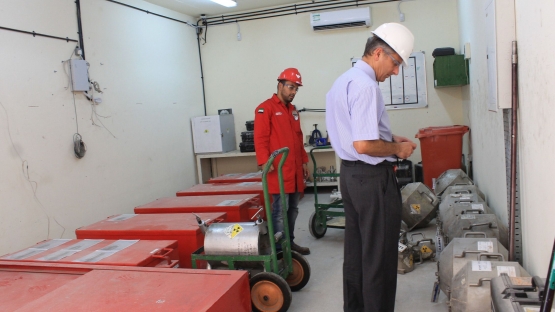Ionizing radiation has many beneficial uses, including in medicine, science and industry, but those working with radiation sources as well as the public and environment need to be protected from its harmful effects. The IAEA offers Member States a thorough review through its Occupational Radiation Protection Appraisal Service (ORPAS) to help in the development of a high-level and effective safety infrastructure for those working with radiation.
Member States need to have stringent safety standards and practices in place to prevent the risk of accidental workforce-related radiation exposure. The IAEA’s Basic Safety Standards and various recommendation documents provide guidance to national authorities. “Radiation protection should be seen as an integral part of general health and safety regulation and management systems in the workplace,” said H. Burçin Okyar, an IAEA radiation safety specialist.
ORPAS in practice: the case of the UAE
During an ORPAS review mission to the United Arab Emirates last November an expert team visited the Federal Authority for Nuclear Regulation (FANR), and facilities involving radiotherapy, nuclear medicine and radiology at three hospitals, two dosimetry services, industrial radiography companies and the country’s General Civil Aviation Authority as well as facilities of the Barakah nuclear power plant that is under construction.
“Conducting an ORPAS mission at a relatively new stage of regulatory development helped FANR and other UAE entities to identify some areas for improvement and good practices related to occupational radiation protection,” said Aayda Ahmed Al Shehhi, Director Radiation Safety at the UAE Federal Authority for Nuclear Regulation.
The review highlighted strengths of the UAE’s occupational radiation protection programme, Al Shehhi said. These include:
- the use of specific dose levels established for workers in different fields, known as practice-specific investigation dose levels, above which workers are referred to a medical review;
- good arrangements for the transport of radioactive sources between storage facilities and radiography sites using a car equipped with tracking devices and emergency equipment.
The evaluation also identified areas where existing safety procedures need to be improved to meet the global safety standards level, Al Shehhi said. Among these recommendations were the following:
- the need to develop criteria for the approval of dosimetry services and issue necessary guidance for its implementation;
- the harmonization of health surveillance procedures for radiation workers and systematized training in radiation protection that requires a new regulatory set up to meet IAEA recommendations, she added.
“These recommendations will be addressed in an action plan to be endorsed by senior government officials for further follow up and implementation,” Al Shehhi said.
ORPAS at a glance
ORPAS provides a review in line with IAEA safety standards, international guidelines and best practices. ORPAS reviews the regulatory framework and practical implementation of occupational radiation protection arrangements at all facilities and for activities utilizing radiation technologies in the host Member State.
“ORPAS provides an independent and unbiased appraisal of the regulatory and practical arrangements for occupational radiation protection across all practices, facilities and relevant technical support organizations,” said Haridasan P. Puthanveedu, a scientific officer in the Health Physics Division of the Bhabha Atomic Research Centre in Kochi, India, who was the team leader of the UAE ORPAS mission.
ORPAS missions in coming months are planned for Malaysia, Uruguay, Costa Rica, Chile, Paraguay, Cuba, Ghana and Morocco.



